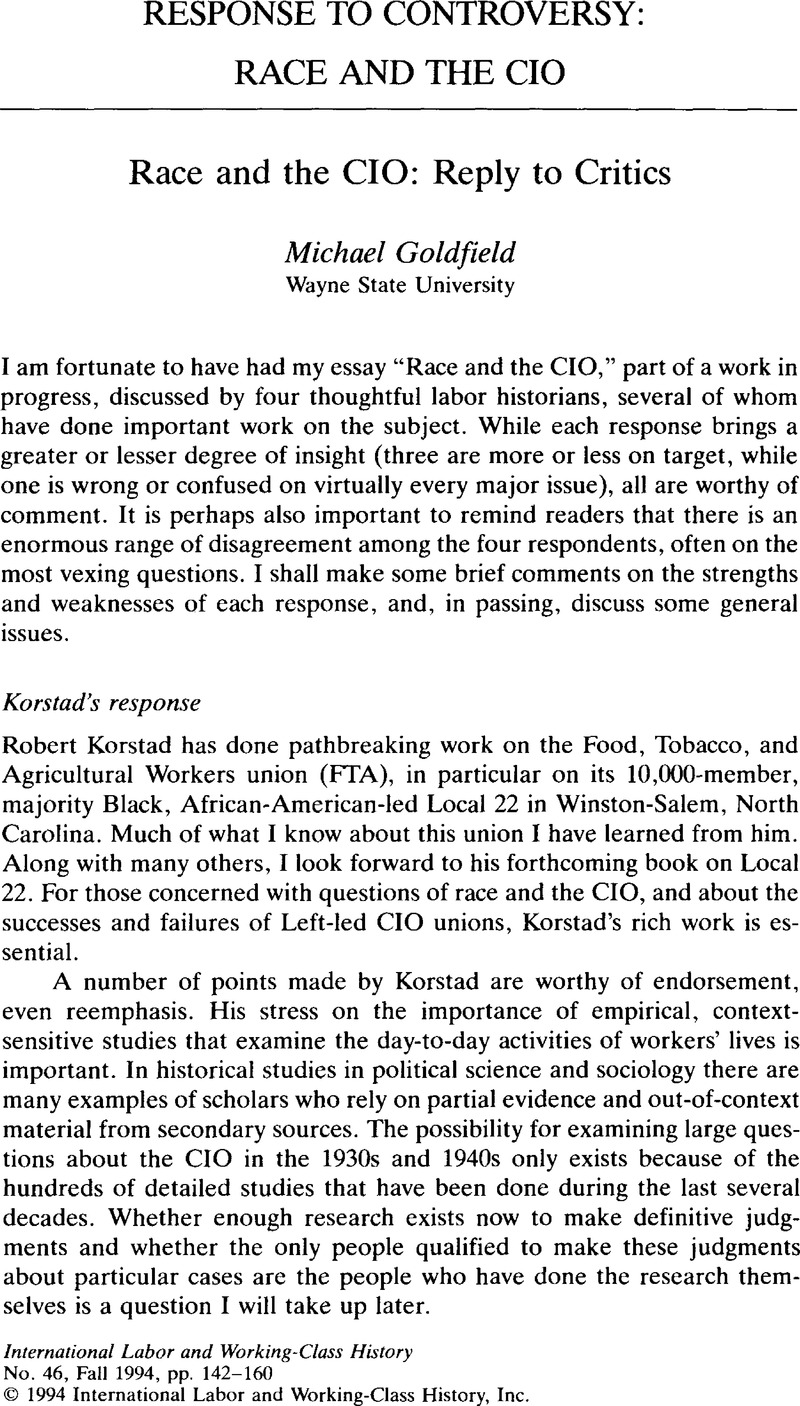Article contents
Race and the CIO: Reply to Critics
Published online by Cambridge University Press: 16 December 2008
Abstract

- Type
- Response to Controversy: Race and the CIO
- Information
- Copyright
- Copyright © International Labor and Working-Class History, Inc. 1994
References
NOTES
1. Gilpin, Toni, “Left by Themselves: A History of the United Farm Equipment and Metal Workers Unions, 1938–1955” (Ph.D. diss., Yale University, 1993).Google Scholar
2. Goldfield, Michael, “The Failure of Operation Dixie: A Critical Turning Point in American Political Development,” in Race, Class, and Community in Southern Labor History, ed. Fink, Gary M. and Reed, Merl E. (Tuscaloosa, Ala., 1994).Google Scholar
3. Fredrickson, George, White Supremacy: A Comparative Study of American and South African History (New York, 1981);Google ScholarGreenberg, Stanley B., Race and State in Capitalist Development (New Haven, Conn., 1980).Google Scholar
4. See Prickett, James, “Communists and the Communist Issue in the American Labor Movement, 1920–1950” (Ph.D. diss., UCLA, 1975);Google Scholar see also Kling, Joseph, “Making the Revolution–Maybe: Deradicalization and Stalinism in the American Communist Party, 1928–1938” (Ph.D. diss., CUNY, 1983).Google Scholar
5. Stepan-Norris, Judith and Zeitlin, Maurice, “‘Red’ Unions and ‘Bourgeois’ Contracts?” American Journal of Sociology 96 (03 1991):1151–1200.CrossRefGoogle Scholar
6. See McColoch, Mark, “The Shop-Floor Dimension of Union Rivalry: The Case of Westinghouse in the 1950s,” in The ClO's Left-led Unions, ed. Steve, Rosswurm (New Brunswick, N.J., 1992).Google Scholar
7. Douglass, Frederick, “The Lesson of the Hour,” 1894 pamphlet reprinted in The Life and Writings of Frederick Douglass, vol. 4, ed. Philip, Foner (New York, 1955), 491–523.Google Scholar
8. Zieger, Robert, “Reply to Professor Lichtenstein,” Industrial Relations 19 (Spring 1980): 133.Google Scholar
9. Weaver to Smith, William, 09 23, 1948Google Scholar, box 54, Southern Organizing Committee papers, Duke University. Weaver says, “I am in complete agreement that no one could be found more deserving, due to the fact that civil rights is not an abstract theory to the officers and staff participating in the Southern Drive.”
10. Gilpin, “Left by Themselves,” 425.
11. Illinois Police and Sheriffs News, September–October 1992, 13.
12. Haywood, Harry, Black Bolshevik (Chicago, 1978), 366–68.Google Scholar
13. Jensen, Vernon H., Nonferous Metals Industry Unionism, 1932–1954. A Story of Leadership Controversy (Ithaca, 1954), 234, emphasis mine.Google Scholar
14. Here, too, one must be careful, as when Dennis Dickerson notes an independent protest by Black longshoremen in 1934 at the AFL convention in San Francisco, with signs reading “Labor Cannot Be Free While Black Labor is Enslaved,”a paraphrase of a sentence from Marx's Capital, popularly quoted by CP activists during the 1930s.
15. Christopher to Ruttenberg, August 30, 1949, reel 32, SOC papers.
16. See Horton to U.S. Attorney General McGrath, January 31, 1951, reel 32, SOC.
17. See Horton, Miles, oral history interview, 12 6, 1974, University of North Carolina Southern Oral History collection.Google Scholar
18. Glaberman, Martin, Wartime Strikes (Detroit, 1980), 73.Google Scholar
19. Dickerson, Dennis C., Out of the Crucible: Black Steelworkers in Western Pennsylvania, 1875–1980 (Chicago, 1986), 183.Google Scholar
20. ibid., 199.
21. Ibid., 195.
22. Aronowitz, Stanley, False Promises (1973; reprinted Durham, N.C., 1992), 235.Google Scholar
- 8
- Cited by


